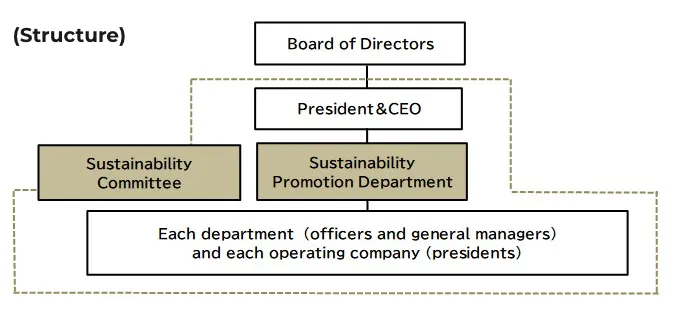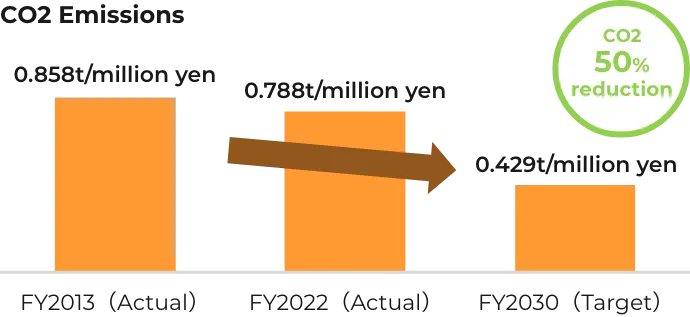Climate Change
Governance
- To promote our sustainability initiatives, including climate change, we have established a Sustainability Committee with members including our executives, general managers of related departments and the presidents of operating subsidiaries, and the Board of Directors will oversee this committee.
- The Sustainability Committee is chaired by President & CEO and the chair directly gives instructions to Sustainability Promotion Department which serves as a committee's secretariat.
- The Board of Directors receives regular reports from the Sustainability Committee on climate change initiatives and oversee the initiatives. When discussing important management issues, the Board of Directors will pay full consideration to this matter.

Strategy
- As a result of climate change, we may face risks such as increasing costs due to the tightening of laws and regulations and the introduction of a carbon tax, destabilizing food supply, rising raw material and energy prices, receiving negative feedback from stakeholders, and getting difficult for our customer to visit our restaurants due to severe natural disasters. These may bring impact on our business and financials directly or indirectly.
- On the other hand, we believe that we can increase our sales and expand our business opportunities by strengthening our environmental initiatives related to climate change including disclosing appropriate information to our stakeholders, and strengthening products and restaurants with low environmental impact.
- We aim to improve business continuity by responding to these risks and capturing opportunities.
Risks, Opportunities,
and Response Policies
| Type | Item | Details | Impact on business and finances |
Timeframe | Our risk management policy and strategies |
||
|---|---|---|---|---|---|---|---|
| Less than 2°C |
4℃ | ||||||
| Transition risk | Policy and Legal |
Strengthening environmental laws and regulations |
Increased costs due to stricter regulations on the use of plastic products, etc. |
△ | △ | Short-term | Promote efforts on reducing the use of plastic products. |
| Transition risk | Policy and Legal |
Introduction of a carbon tax | Increased costs due to the introduction of a carbon tax. |
◎ | △ | Medium-term | Promote the introduction of energy-saving equipment. |
| Transition risk | Market | Unstable food supply Price increases |
Supply of food with low environmental impact becomes unstable, and prices increase. |
○ | △ | Short-term | Diversify risks by offering a variety of restaurant categories and menu, which we think is our strength. Develop sustainable food in cooperation with suppliers. Develop price strategies reflecting the increase in food purchase price. |
| Transition risk | Market | Higher energy prices | Riging energy prices with conversion to renewable energy. |
○ | △ | Medium-term | Promote the introduction of energy-saving equipment. |
| Transition risk and Opportunities |
Reputation | Changes in consumer behavior |
The provision of environmental initiatives and information on environmental initiatives leads to an increase in sales, while the lack of such initiatives and such information leads to a decrease in sales. The sales of products with a high environmental impact will decrease, and the sales of products with a low environmental impact will increase. |
◎ | ○ | Short-term | Strengthen environmental initiatives, disclose appropriate information on the initiatives, and develop products and menu with low environmental impact. |
| Transition risk and Opportunities |
Reputation | Changes in investor behavior Changes in employee behavior |
Strengthening the provision of environmental initiatives and information on environmental initiatives will improve evaluations from investors and employees, while the lack of such initiatives and such information leads to negative feedback. |
○ | △ | Short-term | Strengthen environmental initiatives and disclose appropriate information on the initiatives. |
| Physical risk | Acute | Serious natural disasters |
Increase in scale and frequency of natural disasters will deprive customers of opportunities to visit stores. Supply chain disrupted and food supply no longer available. |
○ | ◎ | Medium-term |
Advance the sophistication of BCP plans (including minimization of losses in the event of disasters). Diversify food suppliers. |
| Physical risk | Chronic | Instability in food supply Price increases |
Food supply becomes unstable and prices rise. |
○ | ◎ | Long-term | Diversify risks by offering a variety of restaurant categories and menu, which we think is our strength. Diversify food suppliers. Develop menu and price strategies reflecting the increase in food purchase price. |
Short-term: 10 years or less,
Medium-term: 30 years or less,
Long-term: More than 30 years
Minor impact: △,
Medium impact: ○,
Large impact: ◎
Risk Management
- We regard the management of climate-related risks as an important management issue, and each business department which belongs to the Sustainability Committee gather information, assess climate-related risks, and take necessary actions in the framework of promoting initiatives on sustainability.
Indicators and Targets
- We use CO2 emissions per unit of net sales (1 million yen) as an indicator, and will work on reducing this amount.
- FY2030, we will aim to reduce CO2 emissions per unit of net sales at least 50% from the level of FY2013 under the target scope 1+2.
FY2013 Actual 0.858t/million yen
→ FY2030 Target: 0.429t/million yen
FY2022 Actual 0.788t/million yen




